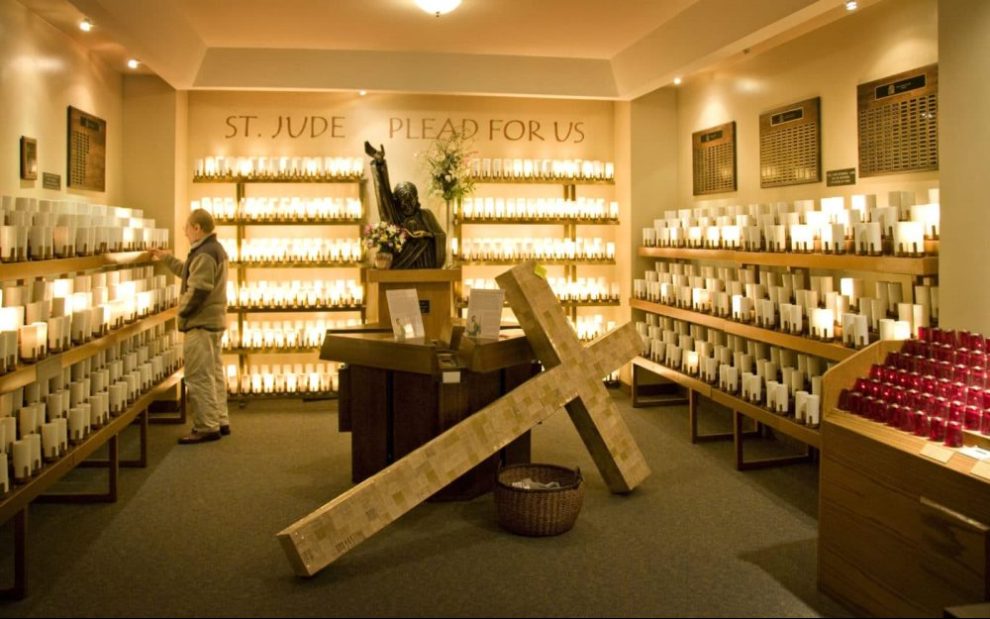Our Lady of Guadalupe Church on Chicago’s South Side was little more than 12 months old when a standing-room-only crowd of more than a thousand worshipers filled its pews and aisles for the conclusion of the first Solemn Novena to St. Jude ever held in the United States.
The date was October 28, 1929, a day before the precipitous stock market crash that ushered in the Great Depression.
By year’s end, the country’s only National Shrine of St. Jude recognized by the Vatican had been officially established at Our Lady of Guadalupe through the efforts of its founder, Father James Tort, C.M.F., an energetic Claretian who served as pastor of the church and as a unifying force for good in the working-class community of South Chicago.
This year the shrine celebrates 75 years of devotion to St. Jude as a beacon of hope and solace for countless people devoted to the once “forgotten apostle” and relative of Christ—the saint now known worldwide as the patron of seemingly impossible or difficult cases.
Within a few months of that first novena, the St. Jude League was formed by Tort to raise funds for the parish as well as to support its diverse ministry to its community of Mexican immigrants. The devotion flourished immediately, drawing second-generation American Catholics from diverse ethnic groups to South Chicago to attend novenas led by well-known priests. The novenas not only sustained the faithful but also helped overcome the ethnic tensions that embroiled the area.
Devotion to St. Jude quickly gained national attention, and the Claretians soon began to adopt innovative ways to meet distant worshipers’ needs. No longer would individuals have to be present at the shrine during the five Solemn Novenas each year. Since then, people who have sought the help of St. Jude have offered novena prayers in their own time and place by mailing petitions to Chicago.
This concept of “pilgrimage by post” revolutionized American Catholic devotional life while it promoted St. Jude’s influence throughout the nation. Today the St. Jude League provides a wealth of devotional materials to members, such as prayer booklets that can be sent to those in need of healing and comfort.
This concept of ‘pilgrimage by post’ revolutionized American Catholic devotional life while it promoted St. Jude’s influence throughout the nation.
Advertisement
People send their petitions for prayers for the difficult situations in their lives and letters of thanksgiving for the comfort and solace St. Jude provides. St. Jude League Director Father John Molyneux, C.M.F. is struck by the steadfast hope of the faithful. “Devotees ask for prayers for their own personal hardships, but they are uniquely committed to praying for one another as a community of believers,” he says. The issues Molyneux sees among league members range from personal illness to prayers for piece and an end to terrorism.
“There is something about St. Jude that captures the hearts of so many people, no matter what their status in life may be,” says Claretian Father James Maloney, pastor of Our Lady of Guadalupe Church.
“Perhaps it is because, through their prayers seeking his intercession, they gain a sense of hope and confidence they can endure whatever troubles are pressing down on them.
A director of the St. Jude League for 30 years, Father Mark Brummel, C.M.F. has read and been inspired by countless letters of thanks to St. Jude that flow into the Claretian office. “The fascinating stories are the ones from a person who has gone through a real tragedy—the loss of a husband or child,” he says. “They are helped in dealing with the situation through prayer.”
Brummel says the changes in a person’s life nurtured through devotion to St. Jude are not to be confused with faith healing. “It’s not a charismatic type of devotion,” he adds. “We don’t have any crutches lying around the altar at the national shrine. It is much more of a silent, inner conversion.”
Devotees of St. Jude acknowledge his intercession in all sorts of ways, including ads in newspaper classified sections. As a result, the image and legend of St. Jude have become part of popular culture and are featured in books, films, and art.
We don’t have any crutches lying around the altar at the national shrine. It is much more of a silent, inner conversion.Father Mark Brummel, C.M.F.
Claretian sponsorship of the devotion to St. Jude has attracted a wide variety of devotees, including the late television star Danny Thomas. In 1962 Thomas fulfilled a personal vow made to St. Jude by building the St. Jude Children’s Research Hospital in Memphis. In both Chicago and California, Thomas worked closely with the Claretian Missionaries to encourage devotion and support the Claretian missions to the forgotten, oppressed, and underprivileged throughout the world.
The devotion to St. Jude, and the early vision of Tort, paved the way for significant religious, social, and educational contributions that the Claretians continue to make today in more than 60 countries. Claretian ministries include inner-city parishes with large Hispanic enrollments; missions in Guatemala, Equatorial Guinea, Jamaica, and Mexico; work as chaplains to Catholic students at secular colleges and universities; and the worldwide publication of magazines, booklets, and newsletters.
In February 1932, Tort founded the police branch of the St. Jude League, and for many years the Claretians provided chaplains for Catholic members of the Chicago police force. Eventually, the branch included more than 4,000 Chicago-area law enforcement officers. The Chicago police still have a lasting affiliation with St. Jude.
“Tort was a little guy, but he could be very persuasive,” recalls Claretian Father Pat McPolin, who served as associate pastor of Our Lady of Guadalupe and chaplain of the St. Jude Police League. “He knew how to get things done, and he had a knack for business. He knew people and places. He was practical as could be. He was a down-to-earth Spanish Catalonian, but he was friendly and outgoing, and that’s what made him such a beloved man.”
Tort was a little guy, but he could be very persuasive.
Father Pat McPolin, C.M.F.Advertisement
Wanting to communicate St. Jude’s message to a national audience, Tort started The Voice of St. Jude in 1935. By 1942, the monthly magazine reached 30,000 homes. Initially intended to spread devotion to St. Jude and information about the Claretian Missionaries, the magazine shifted its focus to educate St. Jude devotees about Catholic social teaching, liturgical reform, and public policy.
As with Tort’s desire to have the best preachers available for the novenas, The Voice of St. Jude invited leading Catholic minds to share their perspectives on racial discrimination, juvenile delinquency, labor issues, and housing and urban problems.
This article also appears in the October 2004 issue of U.S. Catholic (Vol. 69, No. 10, pages 38-41). Click here to subscribe to the magazine.
Image: Courtesy of the National Shrine of St. Jude












Add comment